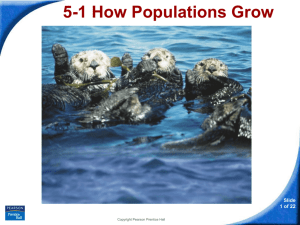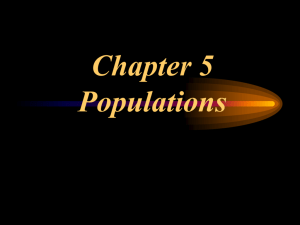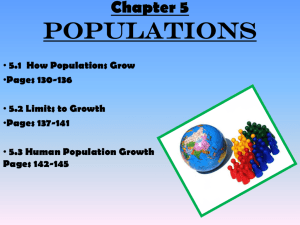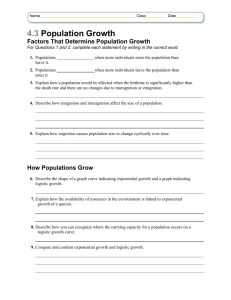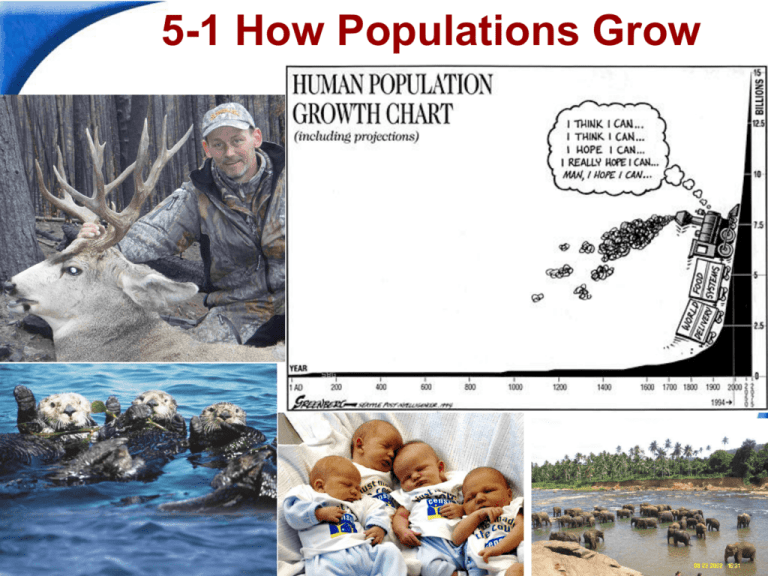
5-1 How Populations Grow
Slide
1 of 22
Copyright Pearson Prentice Hall
End Show
5-1 How Populations Grow
Characteristics of Populations
Characteristics of Populations
Three important characteristics of a
population are its:
• geographic distribution
• population density
• growth rate
Slide
2 of 22
Copyright Pearson Prentice Hall
End Show
5-1 How Populations Grow
Population Growth
What factors affect population size?
per km2
Slide
3 of 22
Copyright Pearson Prentice Hall
End Show
5-1 How Populations Grow
Population Growth
Population Growth
Three factors can affect population size:
• the number of births
• the number of deaths
• the number of individuals that enter or leave
the population
A population can grow when its birthrate is
greater than its death rate.
Slide
4 of 22
Copyright Pearson Prentice Hall
End Show
5-1 How Populations Grow
Population Growth
Immigration, the movement of individuals into
an area.
Emigration, the movement of individuals out
of an area.
Slide
5 of 22
Copyright Pearson Prentice Hall
End Show
5-1 How Populations Grow
Exponential Growth
Exponential Growth
Under ideal conditions with unlimited resources,
a population will grow exponentially.
Exponential growth occurs when the individuals in
a population reproduce at a constant rate.
The population becomes larger and larger until it
approaches an infinitely large size.
Slide
6 of 22
Copyright Pearson Prentice Hall
End Show
5-1 How Populations Grow
Exponential Growth
Exponential Growth
Slide
7 of 22
Copyright Pearson Prentice Hall
End Show
5-1 How Populations Grow
Logistic Growth
Logistic Growth
As resources become less available, the growth
of a population slows or stops.
Logistic growth occurs when a population's growth
slows or stops following a period of exponential
growth.
Carrying Capacity – the largest number of
individuals an environment can support.
Slide
8 of 22
Copyright Pearson Prentice Hall
End Show
5-1 How Populations Grow
Logistic Growth
Logistic growth is characterized by an Sshaped curve.
Slide
9 of 22
Copyright Pearson Prentice Hall
End Show
5-1 How Populations Grow
Limiting Factors
Use the data on page 123 to graph the growth
of both the fruit fly and rabbit populations.
Slide
10 of 22
Copyright Pearson Prentice Hall
End Show
5-1
Click to Launch:
Continue to:
- or -
Slide
11 of 22
End Show
Copyright Pearson Prentice Hall
5-1
Population density is the number of individuals
a. that are born each year.
b. per unit area.
c. that immigrate.
d. that emigrate.
Slide
12 of 22
End Show
Copyright Pearson Prentice Hall
5-1
When the birthrate of a population exceeds its
death rate, the population
a. decreases.
b. increases.
c. stays the same.
d. increases then decreases.
Slide
13 of 22
End Show
Copyright Pearson Prentice Hall
5-1
An S-shaped curve on a graph of population
growth is characteristic of
a. exponential growth.
b. logistic growth.
c. carrying capacity.
d. delayed growth.
Slide
14 of 22
End Show
Copyright Pearson Prentice Hall
5-1
Exponential growth in a population slows down
or stops as
a. resources become limited.
b. rate of immigration increases.
c. rate of emigration decreases.
d. birth rate increases.
Slide
15 of 22
End Show
Copyright Pearson Prentice Hall
5-1
Exponential growth rate means that each new
generation of a population
a. adds the same number of new individuals as
the previous generation did.
b. increases at the same rate as the previous
generation.
c. is the same size as the generation before.
d. increases by a varying amount.
Slide
16 of 22
End Show
Copyright Pearson Prentice Hall
END OF SECTION




